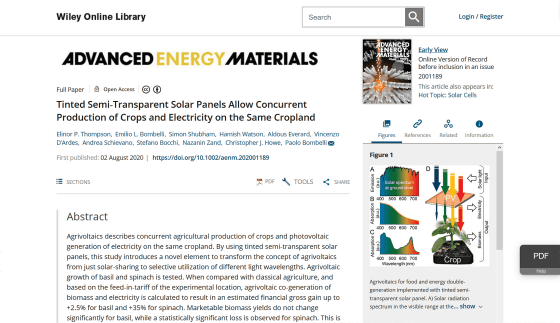Possibility of improving the efficiency of “cultivating crops while solar power generation” agriculture with colored translucent solar panels

An attempt to install a solar panel for solar power generation at a high position on a pillar or the like and to perform agriculture in the space below it is called '
Tinted Semi‐Transparent Solar Panels Allow Concurrent Production of Crops and Electricity on the Same Cropland-Thompson--Advanced Energy Materials-Wiley Online Library
https://onlinelibrary.wiley.com/doi/full/10.1002/aenm.202001189
Maximize production of electricity and crops—tinted semitransparent solar panels for agrivoltaics | The American Ceramic Society
https://ceramics.org/ceramic-tech-today/environment/tinted-semitransparent-solar-panels-for-agrivoltaics

It was in 1981 that farm-type photovoltaic power generation was proposed, but in recent years, due to the increase in the efficiency of photovoltaic power generation and the increased economic pressure on small-scale farmers, it has regained attention. I am. In farming type solar power generation, instead of lining up the solar panels closely, by arranging them with appropriate gaps, the sunlight can be delivered to the lower space as well, and the light necessary for the growth of crops can be secured.
The benefits of combining solar power and agriculture aren't the only economic benefits that come from making money from two sources: electricity and agriculture. The solar panels lined up on the farm land protect the crops from extreme wind and temperature changes, and the cooling effect of water on the crops reduces overheating of the solar panels. It is listed as an advantage.
On the other hand, when sunlight is blocked by the solar panel, the amount of light that hits the plant surely decreases.Therefore, the point that the yield of crops decreases compared to normal cultivation is that the It can be said to be a disadvantage. It has been found that lettuce cultivated under solar panels has a 15-30% reduction in yield compared to when it is cultivated under normal conditions. The harvest of tomatoes is said to have decreased by 10% under the condition of solar power generation.

by National Renewable Energy Lab
Therefore, a research team consisting of British and Italian researchers worked on a method of improving the agricultural efficiency of farm-type photovoltaic power generation by controlling the “wavelength of light that passes through the solar panel”.
Plants using the light of the sun photosynthesis we are, but the wavelength of all the light that is included in the sunlight does not mean be used in photosynthesis. Chlorophyll , which is a major photosynthetic pigment of plants, mainly absorbs light of red and blue wavelengths to perform photosynthesis, but reflects light of green wavelength without absorbing it.
The solar panels used in conventional farm-type solar power generation are semi-transparent, absorbing light evenly and attenuating the light that reaches plants. The research team thinks that it may be possible to improve the efficiency of agriculture in farming solar power generation by coloring the wavelength of the light that reaches the plants by coloring the semitransparent solar panel.

In fact, the research team created a semi-transparent solar panel that preferentially absorbs blue and green wavelengths and transmits red wavelength light. With this special solar panel and transparent glass panel, we created an environment for farm-type solar power generation, and actually cultivated basil and spinach to compare the growth rate.
With the installation of a special solar panel, the amount of sunlight reaching the basil and spinach grown under it was reduced by up to 57%, so it was expected that the yield would be drastically reduced. However, compared to actual yields when grown under transparent glass panels, basil reduced by about 15% and spinach by about 26%. The research team explains about this result because the developed solar panel passed the red light used for photosynthesis, which increased the efficiency of photosynthesis.
Although the amount of crops on the market has decreased compared to normal cultivation, income from power generation can be expected with farm-type solar power generation. 'Our experimental data suggests that farm-based solar power generation could bring about a 2.5% increase in economic benefits for basil and 35% for spinach, compared to traditional traditional agriculture,' the team said. Farming solar PV with special solar panels could lead to increased profits.

Related Posts:
in Science, Posted by log1h_ik







